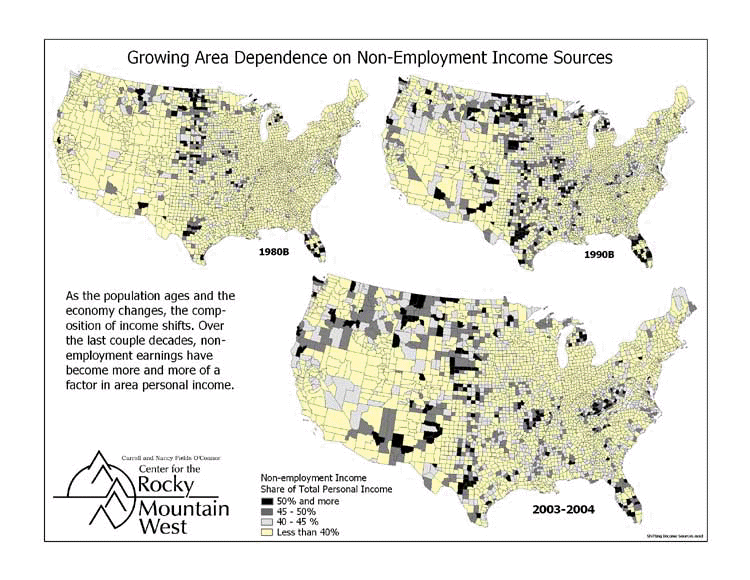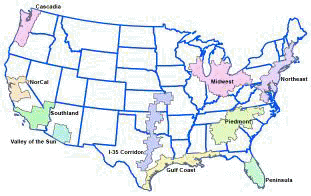Fall 2006, Volume 23.1
READING THE WEST
read-ing [from ME reden, to explain, hence to read] _ vt. 1 to get the meaning of; 2 to understand the nature, significance, or thinking of; 3 to interpret or understand; 4 to apply oneself to; study.
Demographic Shifts
Researchers at the University of Montana’s O’Connor Center for the Rocky Mountain West are studying the dramatic population shifts from rural to urban areas which have left large swaths of the West with dwindling populations and impoverished agricultural and ranching areas. From 2000 to 2006, 83 out of 93 counties in Nebraska lost population. Roughly half the counties in Montana and Wyoming are losing people. However, in spite of the decline in the traditional natural-resource-oriented industries in the rural West, this region is experiencing population growth rates well above those of the nation as a whole, and nontraditional sources of income, employment, and business activity have become more important in the economic base of rural areas. One scholar who is documenting these changes is Larry Swanson.
It is becoming increasingly understood by most people that the U.S. population is aging and that this has very real implications—health care needs are rising, housing needs are changing, school age populations are shrinking, etc. This aging process is also directly impacting the composition and make-up of personal income. For most of this nation’s history, most of the income received by people and families to use for everything they buy came from their employment. However, today more and more areas are receiving as much income from non-employment sources, such as from investments, Social Security and Medicare and Medicaid benefits, as they receive from employment sources, i.e., wage and salary earnings. Areas in dark black in the maps below receive as much or more of their personal income from non-employment sources as from workplace earnings. And there is a heavy concentration of these places in the northern Rockies.

(Source: https://www.crmw.org/newsletter/growingelderlypopulation.htm)

(Source: https://www.crmw.org/newsletter/growingelderlypopulation.htm)
The "New" West
During the 1990s, the Intermountain West witnessed some of the most dramatic population changes in the United States, with growth of over 30 percent between 1990 and 2000. The ‘Old West’ of ranchers, miners, and loggers is being transformed into a ‘New West’ defined by amenity-migrants, retirees, tourists, and other recreation-based industries.
Amenity migration is occurring across the United States; however this migration is especially high in the mountains of the West and Southwest, coastal areas, and near national forests, national parks, or other public lands. Thus, the rural West is an increasingly important destination for migrants who value appealing landscapes and climate. The Western Rural Development Center at Utah State University publishes the newsletter Rural Connections. In the Fall 2006 issue, Linda Kruger reported on the community and environmental effects of amenity migration.
Some of the effects of migration are quite obvious. First, with a large segment of the population nearing retirement age, the location of recreation amenities will play an increasing role in migration patterns. Second, this demand has created opportunities for landowners to make even more money by developing recreational property, resulting in population and landscape change…. One aspect of the change is that disparities between those with sizable inheritances or money from property sales and those without will limit choices for the less fortunate—especially women and minorities…. In addition those who have been living in the areas targeted by amenity migrants may suffer disproportionately as housing and other costs rise. Renters and those on fixed incomes such as those depending on social security and small pensions may be at highest risk. As communities adjacent to public lands become more dependent on the amenity values of those lands, resource management agencies are faced with a new paradigm for promoting community resilience that involves recreation, tourism and sustaining resource values.
There are also environmental concerns associated with this trend. Ocean front, lakes and rivers are often a primary attraction for amenity migrants. The coastal and riparian ecosystems surrounding these areas can be fragile, ecologically sensitive and easily altered by amenity-residence development. Rapid, often unmanaged growth can lead to sprawl, uncontrolled subdivisions, encroachment into previously natural areas and loss of open space and wildlife habitat.
(Source: Kruger, Linda, "Quality of Life Attributes Spur Growth in High Amenity Communities," Rural Connections, 1(Fall 2006): 2-5; https://extension.usu.edu/wrdc)
Megapolitan West
Megapolitan areas are integrated networks of metro-and micropolitan areas. The United States has ten such areas, four in the West. As of 2003, megapolitan areas contained less than one-fifth of all land area in the 48 states, but contained more than two-thirds of the total United States population.
According to a 2005 study by researchers at the Metropolitan Institute at Virginia Tech, these areas extend into 35 states and include parts of every state east of the Mississippi River except Vermont. Four states are completely megapolitan: Connecticut, Delaware, New Jersey and Rhode Island.
In the United States, there are 10 megalopolises with a total population of well over 200 million people—two-thirds of the US population. Six are east of the continental divide, four are west of it, and they comprise both familiar regional agglomerations (e.g., "Cascadia," stretching from Portland, Oregon, to Seattle, Washington; "Northeast," something of an expansion of the "Bowash" corridor) and relatively new ones ("1-35 Corridor," from San Antonio and Dallas, Texas, to Kansas City, Missouri; "Peninsula," encompassing Tampa through Miami, Florida).

(Source: Lang, Robert and Dawn Dhavale, "America’s Megapolitan Areas," Land Lines, July 2005; https://www.lincolninst.edu/pubs. Also: Casio, Jamais, "Transmegapolitan," World Changing, July 30, 2005; https://www.worldchanging.com/archives/003206.html)
